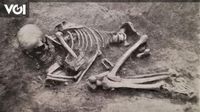In the quiet Chemmani area near Jaffna, in Sri Lanka’s northern region, a chilling discovery has gripped the nation and drawn the world’s attention. Since June 2025, excavations have steadily uncovered a mass grave containing 141 human skeletons—many of them children—alongside haunting remnants of everyday life: a baby bottle, a squeaky toy, a schoolbag, and tiny bead bangles. These findings, reported by multiple outlets including AFP and TRT World, are the latest chapter in Sri Lanka’s painful reckoning with the legacy of its decades-long civil war.
The site, now secured and declared a crime scene, covers 165 square meters (1,776 square feet) and sits on land typically reserved for cremation, not burial. In Chemmani, as in much of the region, Hindu religious customs dictate cremation. The grave’s existence is therefore all the more startling. Workers stumbled upon the first remains while digging for the construction of an electric crematorium, prompting authorities to launch a full-scale excavation. Over just nine days, an initial pit revealed 19 sets of human remains, but the numbers quickly climbed as investigators widened their search.
According to a court report cited by TRT World, the burials are shallow—about 1.5 meters (4.9 feet) deep—and disorganized, with skeletons scattered rather than arranged in an orderly fashion. Most of the bodies, about 135 out of 141, were discovered without clothing, and only one set of adult clothing was identified. Among the most heart-wrenching discoveries: a skeleton found with a schoolbag, confirmed by forensic tests to be a girl between four and six years old. Other items, such as toddlers’ dresses, socks, footwear, and a baby powder tray, further underscore the tragedy that unfolded here.
The identities of the victims, as well as the precise timing and cause of their deaths, remain shrouded in uncertainty. But the context of the site has led many to suspect the remains belong to civilians who disappeared during Sri Lanka’s brutal civil war, which raged from 1983 until its conclusion in 2009. The conflict pitted government forces against ethnic Tamil rebels seeking an independent homeland, with Chemmani serving as a gateway to Jaffna and a stronghold for the Sri Lankan military for more than a decade.
Suspicion has long swirled around the Sri Lankan military’s activities in the region. A decades-old confession has only intensified scrutiny. In 1998, Somaratne Rajapakse, an army soldier, and four accomplices were sentenced to death for the rape and murder of a schoolgirl, as well as the killing of her mother, brother, and a neighbor. Though never executed—Sri Lanka maintains a moratorium on the death penalty—the men have steadfastly claimed they were not involved in the killings but were ordered simply to dispose of the bodies. In court, Rajapakse claimed to know the locations of up to 400 bodies buried in Chemmani. In 1999, he even led police to several burial sites, but those investigations were abruptly halted, leaving questions to linger for decades.
“We cannot say exactly who the perpetrators are yet, but the finger points to the (state) army,” Brito Fernando, an activist working with families of the disappeared, told TRT World. The military’s dominance in the area from 1996, when it recaptured Jaffna from Tamil rebels, until after the war’s end, has fueled suspicions. Military checkpoints were commonplace, and anyone entering or leaving Chemmani was subject to searches. According to Nadesapillai Vithyatharan, editor of the region’s only newspaper during the conflict, many families disappeared after being stopped at such checkpoints, particularly those returning from rebel-held territory.
Despite the mounting evidence and public suspicion, no formal accusations have been filed against the army as of August 21, 2025. Army spokesman Brigadier Waruna Gamage emphasized to reporters, “The excavations are still ongoing, and it is a civil matter belonging to the police and courts. We will respect the law of the country.” He added that if accusations were made, proof would be required.
The pain of uncertainty is felt most acutely by families of the missing. Earlier this month, items recovered from the grave were displayed in the hope that relatives might recognize them. Amalanathan Mary Calista, whose husband vanished in 1996 after being arrested by the military, described her bittersweet visit. “I went there hoping to see at least his clothes. There was a sarong but it wasn’t my husband’s. He was wearing a blue sarong at the time. It was disappointing,” she told TRT World. She added, “The state army arrested him. They must say that they arrested him and that he died at their hands. They also must pay us compensation.” Calista’s husband is one of 24 people who never returned after a military search in their village.
The search for answers is complicated by the lack of comprehensive records. A 2003 report from Sri Lanka’s Human Rights Commission investigated 281 complaints of missing persons from 1990 to 1998. While three individuals were eventually found in prison and released, the rest remain unaccounted for. Notably, none of the missing were listed as children, raising further questions about the identities of the young victims found in Chemmani.
Calls for a thorough and transparent investigation have grown louder. Fernando, the activist, argues that Sri Lanka lacks the necessary guidelines and infrastructure to investigate mass graves effectively. “We don’t have proper guidelines to investigate the mass graves and have no DNA bank to help with identification,” he said, urging the government to fund a DNA bank and seek international assistance. “Only a proper investigation by the government can free its military from suspicion.”
Legal observers, such as lawyer Ranitha Gnanarajah, note that the scanned area is three times larger than what has already been excavated. Investigators have requested court approval to continue digging for another eight weeks. Hopes are pinned on DNA analysis and further excavations to finally identify the victims and bring closure to families who have waited decades for answers.
The Chemmani mass grave is a grim reminder of the unresolved wounds left by Sri Lanka’s civil war. Both government forces and Tamil rebels have been accused of atrocities amounting to war crimes, especially in the conflict’s final months. As the world watches, Sri Lanka faces a pivotal moment: will it confront the darkest chapters of its past and provide justice for the disappeared, or will the truth remain buried alongside the victims in Chemmani?
For now, the excavations continue, each spadeful of earth carrying the weight of history and the hope of long-awaited closure for families across the island.



